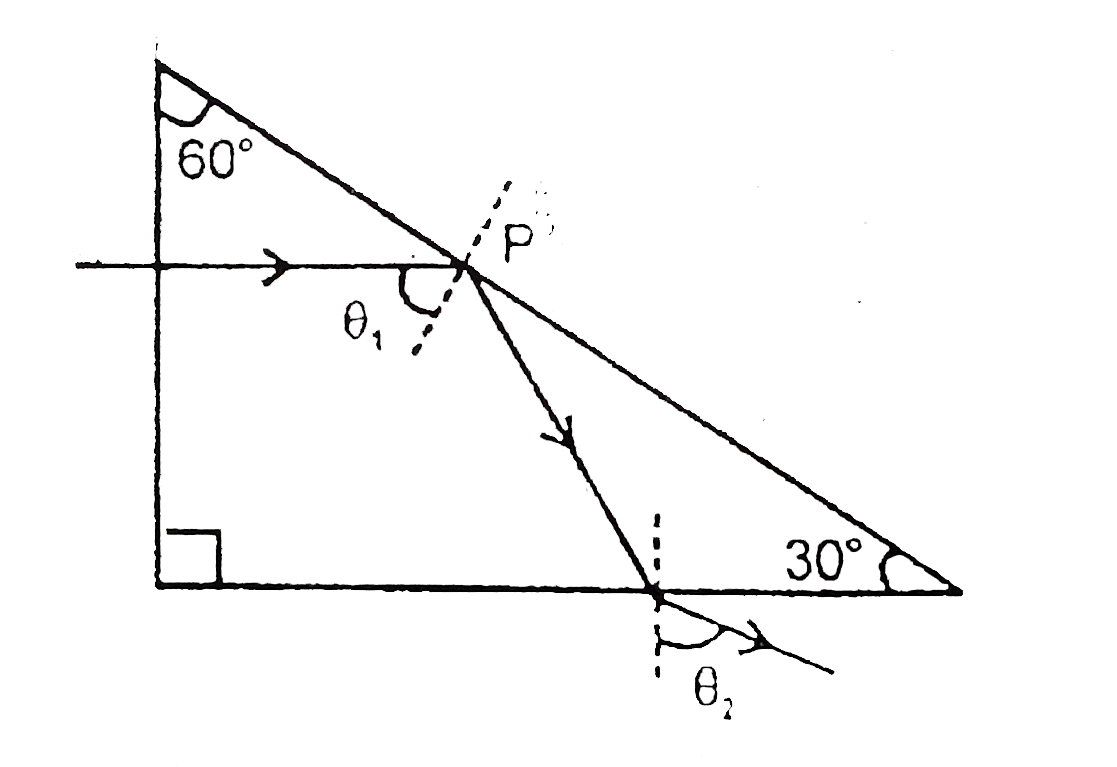A ray of light incident at an angle θ on a refracting face of a prism emerges from the other face normally. If the angle of the prism is 5∘ and the prism is made of a material of refractive index 1.5, the angle of incidence is.
7.5∘
5∘
15∘
2.5∘
To solve the problem, we will follow these steps:
Step 1: Understand the Geometry of the Prism
We have a prism with an angle A=5∘. A ray of light is incident at an angle θ on one face of the prism and emerges normally from the other face.
Step 2: Identify Angles
When the ray emerges normally from the second face, the angle of refraction R2=0∘. The angle of incidence on the second face is equal to the angle of the prism A minus the angle of refraction R2:
R1+R2=A
Since R2=0∘, we have:
R1=A=5∘
Step 3: Apply Snell's Law
Using Snell's law at the first interface (air to prism):
n1sinI1=n2sinR1
Where:
- n1=1 (refractive index of air)
- n2=1.5 (refractive index of the prism)
- R1=5∘
Substituting the known values into Snell's Law:
1⋅sinI1=1.5⋅sin(5∘)
Step 4: Calculate sin(5∘)
Using a calculator or trigonometric tables, we find:
sin(5∘)≈0.0872
Step 5: Substitute and Solve for I1
Substituting sin(5∘) into the equation:
sinI1=1.5⋅0.0872≈0.1308
Now, we find I1:
I1=arcsin(0.1308)
Using a calculator:
I1≈7.5∘
Conclusion
The angle of incidence I1 is approximately 7.5∘ or 7∘30′.
---
We have a prism with an angle A=5∘. A ray of light is incident at an angle θ on one face of the prism and emerges normally from the other face.
When the ray emerges normally from the second face, the angle of refraction R2=0∘. The angle of incidence on the second face is equal to the angle of the prism A minus the angle of refraction R2:
R1+R2=A
Since R2=0∘, we have:
R1=A=5∘
Using Snell's law at the first interface (air to prism):
n1sinI1=n2sinR1
Where:
- n1=1 (refractive index of air)
- n2=1.5 (refractive index of the prism)
- R1=5∘
1⋅sinI1=1.5⋅sin(5∘)
Using a calculator or trigonometric tables, we find:
sin(5∘)≈0.0872
Substituting sin(5∘) into the equation:
sinI1=1.5⋅0.0872≈0.1308
Now, we find I1:
I1=arcsin(0.1308)
Using a calculator:
I1≈7.5∘
The angle of incidence I1 is approximately 7.5∘ or 7∘30′.
Topper's Solved these Questions
- RAY OPTICS AND OPTICAL INSTRUMENTS BOOK - NCERT EXEMPLAR ENGLISHCHAPTER - RAY OPTICS AND OPTICAL INSTRUMENTS EXERCISE - MULTIPLE CHOICE QUESTIONS (MORE THAN ONE OPTIONS )
6 Videos
- RAY OPTICS AND OPTICAL INSTRUMENTS BOOK - NCERT EXEMPLAR ENGLISHCHAPTER - RAY OPTICS AND OPTICAL INSTRUMENTS EXERCISE - VERY SHORT ANSWER TYPE QUESTIONS
16 Videos
- NUCLEIBOOK - NCERT EXEMPLAR ENGLISHCHAPTER - NUCLEIEXERCISE - Long answer type question
10 Videos
- SEMICONDUCTOR ELECTRONICS: MATERIAL,DEVICES AND SIMPLE CIRCUITBOOK - NCERT EXEMPLAR ENGLISHCHAPTER - SEMICONDUCTOR ELECTRONICS: MATERIAL,DEVICES AND SIMPLE CIRCUITEXERCISE - Multiplel choice questions
26 Videos
Similar Questions
Find the angle of minimum deviation for an equilateral prism made of a material of refractive index 1.732. What is the angle of incidence for this deviation ?
View Solution
A ray of light is incident normally on one face of a prism as shown in figure. The refractive index of the material of the prism is 53 and the prism is immersed in water of refractive index 43, then
View Solution
Knowledge Check
A ray of light is incident at small angle I on the surface of prism of small angle A and emerges normally from the oppsite surface. If the refractive index of the material of the prism is mu, the angle of incidence is nearly equal to
AAμBA2μCμADμA2
When a ray of light is incident normally on one refracting surface of an equilateral prism (Refractive index of the material of the prism =1.5
View SolutionWhen a ray of light is incident normally on one refracting surface of an equilateral prism (Refractive index of the material of the prism =1.5)
View SolutionA ray of light is incident at small angle I on the surface of prism of small angle A and emerges normally from the oppsite surface. If the refractive index of the material of the prism is mu, the angle of incidence is nearly equal to
View SolutionA ray of light is incident at small angle I on the surface of prism of small angle A and emerges normally from the oppsite surface. If the refractive index of the material of the prism is mu, the angle of incidence is nearly equal to
View SolutionA ray of light incident at an angle 90° with the face of an equilateral prism passes symmetrically. Calculate the refractive index of the material of the prism
View SolutionA ray of light falls on a normally on a refracting face of a prism. Find the angle of prism if the ray just fails to emerge from the prism (μ=3/2).
View SolutionA light ray is incident normally on one of the refracting faces of a prism and just emerges out grazing the second surface. Then, the relation between angle of the prism and its critical angle is
View Solution
